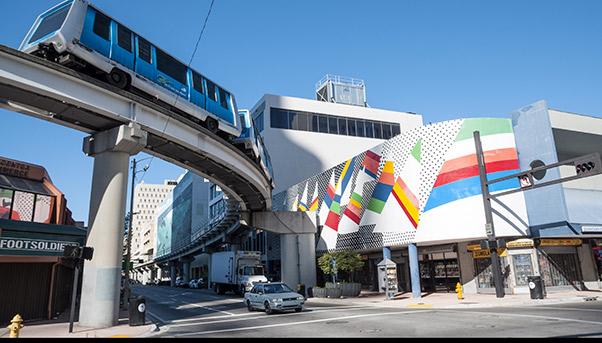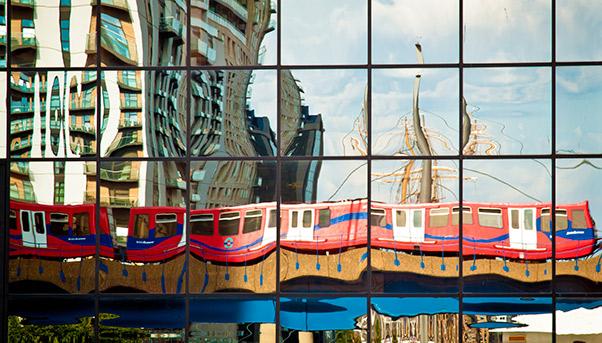
At one time the term “runaway train” was a metaphor for a situation that had gone out of control. But technology can free us of these old nightmares. The new generation of automated trains - those without a driver – are being put to use on more metro lines across the planet. Metro projects that are being built or are still lingering on the drawing board have a number of lines going underground and above it in equal measure. And it is not uncommon to have both solutions come together.
One example is the solution adopted in Sydney, where the Salini Impregilo Group is working on a section of the Sydney Metro Northwest between Bella Vista and Rouse Hill. The project foresees the construction of eight stations along 23 kilometres with parking space made available for a total of 4,000 vehicles. The elevated part called Skytrain is a part of the section being built by Salini Impregilo, and it will run between five and 13 metres above ground for 4.6 kilometres. It will be supported by 120 columns, distributed at standard intervals of 39 metres. It will be ready by early 2017 (37 months since work began in January 2014).
Driverless Evolution
The new generation of metros represent a future that has already arrived and been submitted to international study for its best practices to be shared. The International Association of Public Transport (UITP) is an international organization that brings together public transport authorities and operators from 92 countries, including Italy. It has an observatory that is a permanent structure that explores and shares pertinent information about the metro lines that use automated technology to drive their trains (metro automation). It is working on a classification of the various forms of automated trains: the handling of the interaction between the trains and their passengers appears as a discerning criterion that is also relevant for the classification established by the Grade of Automation (GoA) that is given to the basic functions of train operation, whether by staff or not.

For traditional lines that do not have any type of automation – such as one the red, green and yellow lines of the Milan metro network - they get the lowest ranking, or GoA 1. In these cases it is a human being who drives the train, stops it and opens and closes its doors at each station. GoA 2 recognises the introduction of some essential elements of automation: although there is still someone of flesh and blood in the driver’s seat, the displacement between stations is done by a cybernetic system. The human’s responsibility is to supervise the opening and closing of the doors. GoA 3 deals with the interaction with passengers with a little more courage: a human is no longer present in the driver’s seat but the train is still accompanied by a human attendant, whose duty is to monitor the doors and intervene in case of emergency. The highest ranking is GoA 4, which represents the apotheosis of robotics applied to the metro. Human presence or intervention is banished, with the full management of the train rendered to technology. In Italy, one can observe this muscular exhibition of artificial intelligence on Milan’s Line 5, Rome’s Line C , Brescia’s metro and Turin’s M1 Line. But examples are becoming more numerous, making the driverless metro, one without a driver, the real symbol of sustainable urban mobility.
Widespread Technology
Globally, there are 77 automated metros, 21 of which operate in Europe. The United States holds the record with 15 lines that are totally automated, while in Europe, France has the record with nine lines. According to the latest comprehensive survey from 2013, there are 674 kilometres of metro that operate by themselves in the world: they transport passengers in 32 cities with 700 stations.
Since the publication of the results, four more lines have been added at a rate that the UITP estimates will lead to a tripling in the next 10 years of the number of kilometres serviced.

By 2025, the total is expected to reach 1,800 kilometres. Europe is the leader in terms of the diffusion of the service today as well as the prospects for it to grow in the future. Notwithstanding this leadership, the three biggest automated lines in service are not located on the Old Continent. They are to be found in Dubai, Singapore and Vancouver.
In Europe as well as Asia, Salini Impregilo is involved in the construction of lines with a GoA 4 ranking. One is Milan’s Line 4. It will run 14.2 kilometres, connecting the Linate city airport with the San Cristoforo train station. There will be 21 stations, which are expected to serve 24,000 passengers travelling in each direction every hour. Although the company is Italian, its work is international. Elsewhere in the European Union, it is working on projects in Copenhagen and Thessaloniki, Greece.
In the Danish capital, it is doing the Cityringen, a ring that runs for 17.4 kilometres around the city centre with 17 stations located 30 metres below ground. Once it is up and running, it will provide service 24 hours a day. In Salonicco, it is working on a single line of 9.6 kilometres. Trains will arrive at each station at a frequency of 90 seconds during peak time, carrying 18,000 passengers an hour. The most ambitious project is not to be found in Europe, but Saudi Arabia. The capital of Riyadh has six million inhabitants and it is one of the cities most congested with traffic in the world. In order to ease the traffic jams, the city has embarked on a Titanic project that will cover the urban area with a metro network of six lines for more than 150 kilometres in a few years. Salini Impregilo is involved in the construction of Line 3, the longest of them all. Stretching 41.58 kilometres with 22 stations, it is set to be finished in four years.
The Future and Robotics
Standards have evolved since the pioneering experiments of 30 years ago. The first trains to enter the era of automation carried less than 300 passengers. Today, they can carry 700. Research and development in this field has grown thanks to the progressive decline in the cost of implementing the technology and the rise in the quality of the service provided. The construction of automated metros has significantly reduced the number of accidents registered in the public transport sector. It has also favored operational flexibility. To take us out of the tunnel, so to speak, are robotics.


